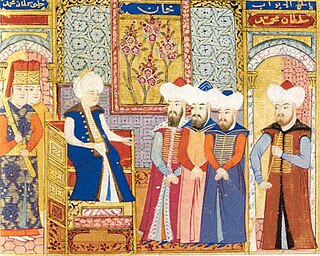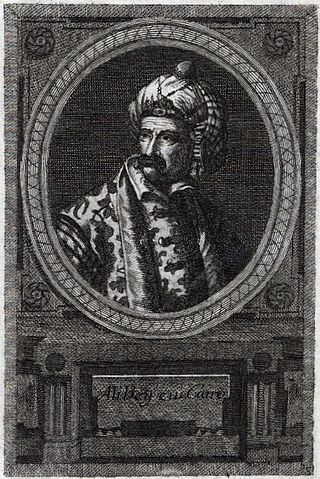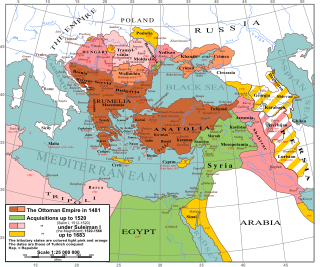Related Research Articles

Mehmed I, also known as Mehmed Çelebi or Kirişçi, was the sultan of the Ottoman Empire from 1413 to 1421. The fourth son of Sultan Bayezid I and Devlet Hatun, he fought with his brothers over control of the Ottoman realm in the Ottoman Interregnum (1402–1413). Starting from the province of Rûm he managed to bring first Anatolia and then the European territories (Rumelia) under his control, reuniting the Ottoman state by 1413, and ruling it until his death in 1421. Called "The Restorer," he reestablished central authority in Anatolia, and he expanded the Ottoman presence in Europe by the conquest of Wallachia in 1415. Venice destroyed his fleet off Gallipoli in 1416 as the Ottomans lost a naval war.

Murad II was the sultan of the Ottoman Empire from 1421 to 1444 and again from 1446 to 1451.

Ali Bey al-Kabir was a Mamluk leader in Egypt. Nicknamed Jinn Ali and Bulut Kapan ("Cloud-Catcher"), Ali Bey rose to prominence in 1768 when he rebelled against his Ottoman rulers, making the Egypt Eyalet of the Ottoman Empire independent for a short time. His rule ended following the insubordination of his most trusted general, Abu al-Dahab, which led to Ali Bey's downfall and death.

The Karamanids, also known as the Emirate of Karaman and Beylik of Karaman, was one of the Anatolian beyliks, centered in South-Central Anatolia around the present-day Karaman Province. From the mid 14th century until its fall in 1487, the Karamanid dynasty was one of the most powerful beyliks in Anatolia.

The Ramadanid Emirate was an autonomous administration and a de facto independent emirate that existed from 1352 to 1608 in Cilicia, taking over the rule of the region from the Armenian Kingdom of Cilicia. The emirate was a protectorate of the Mamluk Sultanate until the end of 14th century, then it was de facto independent for more than a century, and then, from 1517, a protectorate of the Ottoman Empire. The capital was Adana.
Ibrahim II was a bey of Karaman.

Mustafa Çelebi, also called Mustafa the Impostor, was an Ottoman prince who struggled to gain the throne of the Ottoman Empire in the early 15th century. He was the Sultan of Rumelia twice during January 1419 – 1420 and January 1421 – May 1422.
Mehmet II of Karaman, Mehmed Beg, Mehmed Beg II, also known as Nasir al-Din Mehmed Beg was the ruler of Karaman in what is now modern Turkey in the 15th century. His mother was Nefise Hatun, a daughter of Sultan Murad I.

Şehzade Korkut was an Ottoman prince who was for a short time the regent for the Ottoman throne.
Ali of Karaman was the bey of Karamanids in what is now modern Turkey in the 15th century.
Şehzade Halil was an Ottoman prince. His father was Orhan, the second bey of the Ottoman beylik. His mother was Theodora Kantakouzene, the daughter of Byzantine emperor John VI Kantakouzenos and Irene Asanina. His kidnapping was an important event in 14th century Ottoman-Byzantine relations. He was killed by his brother Murad I.
Güneri of Karaman was the third bey of Karaman Beylik, a Turkish principality in Anatolia in the 13th century.
Mahmut of Karaman was a bey of Karaman Beylik, a Turkish principality in Anatolia, 14th century.
Musa of Karaman, a.k.a. Hacı Sufi Burhanettin Musa, was a bey of Karaman Beylik, a Turkish principality in Anatolia in the 14th century.

Halil, also known as Alaeddin Halil, was a bey of Karaman Beylik, a Turkoman principality in Anatolia in the 14th century.
Alaeddin Ali of Karaman was a bey of Karaman Beylik, a Turkish principality in Anatolia in the 14th century. Like most other Karaman beys, Ali Bey was a rival of the rising Ottoman Empire, and the two principalities engaged in chronic wars against one another.
Süleyman of Karaman was a bey of the Karaman Beylik, a Turkish principality in Anatolia in the 14th century.
Ishak of Karaman was a bey of the Karamanids, a Turkish principality in Anatolia in the 15th century.
Beylik of Tacettin was a small Turkmen principality in Anatolia in the 14th and 15th centuries.

Giyath al-Din Muhammad was the second sultan of the Eretnids.
References
- ↑ Prof. Yaşar Yüce-Prof. Ali Sevim: Türkiye tarihi Cilt I, AKDTYKTTK Yayınları, İstanbul, 1991 p 245